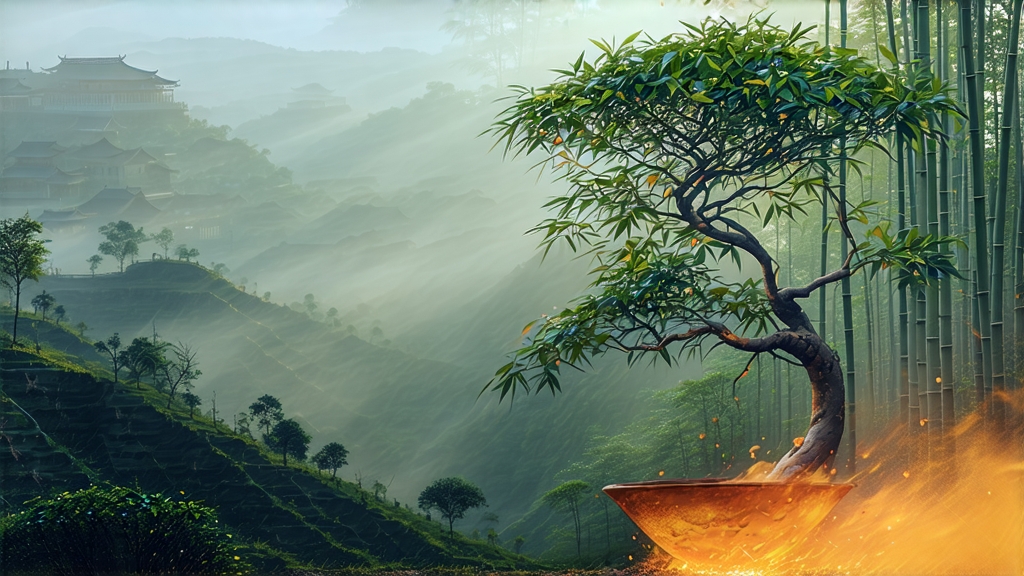
If oolong is the jazz of tea—improvisational, layered, always evolving—then Phoenix Dancong from Guangdong Province is the saxophone solo that makes the room fall silent. For eight centuries this tea has carried the scent of orchards, forests and incense-filled temples in one curled leaf, and every sip still feels like overhearing a conversation between Song-dynasty poets and modern charcoal fires.
-
Origins: from imperial tribute to living gene bank
Legend says that during the Southern Song (1127-1279) the emperor’s retinue fled the Mongol advance and rested on Phoenix Mountain (Fenghuang Shan) in Chaozhou prefecture. Local She ethnic villagers served roasted leaves from centuries-old wild trees; the infusion’s natural honey-peach perfume revived the imperial spirits. The court declared the tea “Wu-di cha” – “the tea that evokes memory of lost empire” – and annual tribute caravans began. By the Ming, merchants had coined the name “Dancong,” literally “single bush,” because the most prized pickings came from individual mother trees whose flavor could not be replicated even a few metres away. Today the 3,500-hectare core zone protects 20,000 ancient trees aged 200-900 years, a living arboretum of over 80 aromatic sub-cultivars. -
Aromatic taxonomy: the “fragrance dictionary”
Chaozhou tea masters speak of “xiang xing” – fragrance archetypes – rather than cultivar in the Western sense. Each ancient tree is vegetatively propagated by air-layering, creating a clonal line that preserves its signature scent. The most celebrated include:- Huangzhi Xiang (gardenia with cooked peach)
- Milan Xiang (honey-orchid)
- Zhilan Xiang (orchid-vanilla)
- Xingren Xiang (bitter almond milk)
- Yashi Xiang (duck-shit, a deliberately humble name to deter thieves; the cup is lilac-cream)
- Tongtian Xiang (literally “heaven-piercing,” a lychee-rose explosion found on one 700-year-old tree halfway up a cliff).
Because every slope, altitude and mineral band alters gene expression, two genetically identical bushes grown on opposite sides of a ravine can diverge like estranged twins, giving Dancong the most complex sensory map in the oolong family.
-
Craft: the charcoal waltz across 24 hours
Harvest is still done by rope-climbing pickers who ascend 800- to 1200-metre granite cliffs at dawn. Only the middle three leaves and the insect-bitten “dew tip” are plucked; leaf-hopper bites trigger enzymatic pathways that intensify floral lactones. The leaves are spread on bamboo sieves under high-mountain sun for 20 minutes, long enough to wilt but not bruise. Indoors, they are shaken in rattan trays every hour from 6 p.m. to 2 a.m.—a ritual called “qing wei” (aroma waking) that oxidises the edges to 30 % while the leaf spines stay green. At 3 a.m. the master builds a coconut-shell charcoal pit at 220 °C; leaves are flash-baked for 90 seconds to arrest oxidation, then rolled on linen mats until they curl into dragon-whisker strips. The critical step is the second charcoal firing: low embers at 80 °C for 6-10 hours, repeated up to three times over the next month. The baker sleeps in 20-minute cat-naps, nose tuned to the rising scent of frangipani and caramel; one degree too hot and the volatile esters collapse. The finished tea contains 147 aromatic compounds—three times that of Darjeeling. -
Tasting lexicon: how to listen to a Song-dynasty playlist
Professional cuppers in Chaozhou use a 110 ml white porcelain gaiwan, 5 g of leaf, and water at 98 °C. The first infusion, 5 seconds, is discarded as “tea soul washing.” The second, 8 seconds, releases the “head note”: expect a bright aria of peach skin and alpine peony. By the fourth infusion the “mountain rhyme” (shan yun) arrives—a cooling camphor finish that lingers like mint on a glacier. The seventh infusion turns